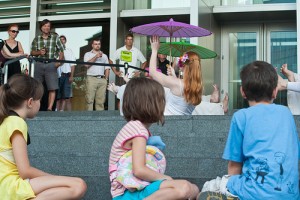Getting your dancers out into the community: It can be a great opportunity to highlight your program or company. It can also present challenges.
I’ve organized or been a part of a few informal performances and, in addition to small or unconventional spaces (malls, bookstores, lobbies, all-purpose rooms), there are sometimes dancers of varying experience performing together, large groups, limited rehearsal times, and the whole thing can feel like it’s getting out of hand rather quickly.
Keep It Simple!
 In these cases, I’ve found it valuable to adopt the K.I.S.S. method in every single way.
In these cases, I’ve found it valuable to adopt the K.I.S.S. method in every single way.
I remind myself that it is okay for a performance which takes place in an informal setting to have an informal feel.
Organized! But informal.
Though you may want to ‘wow’ your audience, complex choreography in this situation can look messy. To an experienced dancer, your choreography many not seem all that challenging but spectators often have a different view.
Simple and clean will win over your audience and allow everyone to keep their sanity as you prepare for your event.
Here are just a few tips, to help you as you create uncomplicated choreography for an unconventional space
- Use only familiar skills which your dancers can perform competently.
- If the dances seem almost too easy, you are probably on the right track.
- Use repetition…
- But keep things interesting by manipulating groups of dancers, tempos, formations, or levels.
- Mix or alternate dance steps/skills with basic arm movements that are easy to clean.
- Use familiar, “pedestrian” movements whenever you can (walking, skipping, marching)
- For mixed ages, get the older ones to help or guide or lead the younger ones.
- Keep costuming simple: something everyone has in their wardrobe. A solid t-shirt with jeans or jazz pants or shorts. Their dance uniform. Your school’s logo t-shirt.
- One costume for everything. If you feel certain songs require something that differentiates, choose one simple accessory that can be added or subtracted from the base outfit.
- Keep the music simple: Break one long song into chunks and choreograph it in sections for different groupings.
- Plan short, easy transitions between these sections or between performance numbers.
- Practice these transitions. Unconventional spaces rarely have stage wings. Practicing how and where dancers should stand while not part of the main action will prevent unwanted distractions.
- Use songs with clear beats so dancers can stay together easily.
Now, after all that encouragement to keep it simple, I present an alternative to the informal performance. The organization level on something like this goes way up but I couldn’t do a post on unconventional spaces without mentioning the ever-popular flash mob dance.
Unparalleled Performances in Unconventional Spaces
In postmodern dance, we call them “site specific.” Flash mob dances are the pop culture cousin, I suppose. These are dances that thrive in unique or unorthodox performance spaces.
For a college project I choreographed a dance in a swimming pool. Other classmates, I recall, repelled from campus sculpture, used a peculiar stairway, and explored various other nooks. Site-specific work has its own history in dance (read this Barnard senior thesis for more on that: download the doc).
If you are working with skilled or experienced dancers, a site-specific performance or random-act-of-dance project might be a great way to create some buzz in your community (just make sure you investigate any legal concerns and contact officials for necessary permissions).
Your performance will be enhanced by intent to really relate to the chosen space. In other words, make the space an integral part of your choreography.
Inspiration can be found in films and viral videos all around the web. Here are just a few examples of dance in unique spaces:
Have you organized an informal performance in an unconventional space?
How about a site-specific or flash mob dance?
What are your tips for making it a success?
Nichelle Suzanne is a writer specializing in dance and online content. She is also a dance instructor with over 20 years experience teaching in dance studios, community programs, and colleges. She began Dance Advantage in 2008, equipped with a passion for movement education and an intuitive sense that a blog could bring dancers together. As a Houston-based dance writer, Nichelle covers dance performance for Dance Source Houston, Arts+Culture Texas, and other publications. She is a leader in social media within the dance community and has presented on blogging for dance organizations, including Dance/USA. Nichelle provides web consulting and writing services for dancers, dance schools and studios, and those beyond the dance world. Read Nichelle’s posts.

